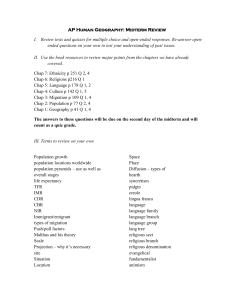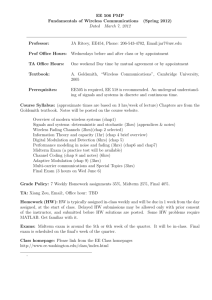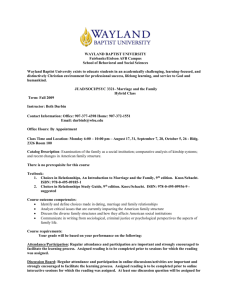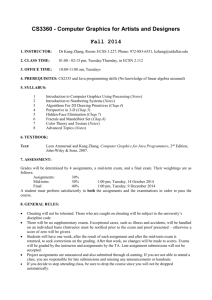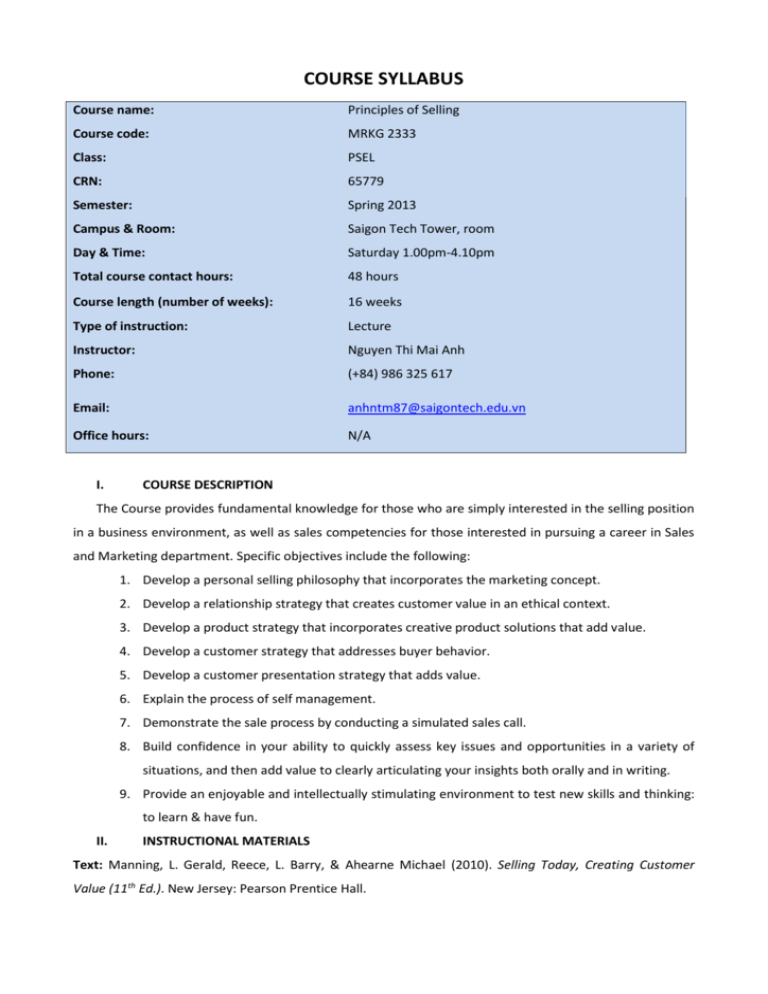
COURSE SYLLABUS
Course name:
Principles of Selling
Course code:
MRKG 2333
Class:
PSEL
CRN:
65779
Semester:
Spring 2013
Campus & Room:
Saigon Tech Tower, room
Day & Time:
Saturday 1.00pm-4.10pm
Total course contact hours:
48 hours
Course length (number of weeks):
16 weeks
Type of instruction:
Lecture
Instructor:
Nguyen Thi Mai Anh
Phone:
(+84) 986 325 617
Email:
anhntm87@saigontech.edu.vn
Office hours:
N/A
I.
COURSE DESCRIPTION
The Course provides fundamental knowledge for those who are simply interested in the selling position
in a business environment, as well as sales competencies for those interested in pursuing a career in Sales
and Marketing department. Specific objectives include the following:
1. Develop a personal selling philosophy that incorporates the marketing concept.
2. Develop a relationship strategy that creates customer value in an ethical context.
3. Develop a product strategy that incorporates creative product solutions that add value.
4. Develop a customer strategy that addresses buyer behavior.
5. Develop a customer presentation strategy that adds value.
6. Explain the process of self management.
7. Demonstrate the sale process by conducting a simulated sales call.
8. Build confidence in your ability to quickly assess key issues and opportunities in a variety of
situations, and then add value to clearly articulating your insights both orally and in writing.
9. Provide an enjoyable and intellectually stimulating environment to test new skills and thinking:
to learn & have fun.
II.
INSTRUCTIONAL MATERIALS
Text: Manning, L. Gerald, Reece, L. Barry, & Ahearne Michael (2010). Selling Today, Creating Customer
Value (11th Ed.). New Jersey: Pearson Prentice Hall.
III.
COURSE STUDENT LEARNING OUTCOMES (SLOs):
1. Define the selling process and its application to all forms of sales.
2. Identify the elements of the communication process between buyers and sellers in
business.
3. Examine ethical issues and legal restrictions of business which affect salespeople.
IV.
STUDENT LEARNING OUTCOMES (SLO) AND LEARNING OBJECTIVES (LO)
Student Learning Outcomes
Learning Objectives (LO)
(SLO)
1. Define the selling process
and its application to all
forms of sales.
1.1 Personal selling – A definition and a philosophy and the
Marketing concept (Chap 1)
1.2 Personal selling opportunities in the Age of information (Chap
2)
2. Identify the elements of
2.1 Developing a relationship strategy: creating value with a
the communication
relationship strategy (Chap 3) and communication styles – a key
process between buyers
to adaptive selling today (Chap 4)
and sellers in business
2.2 Developing a product strategy: creating product solutions (Chap
6) and product-selling strategies that add value (Chap 7)
2.3 Developing a customer strategy: the buying process and buyer
behavior (chap 8) and developing and qualifying a prospect
base (Chap 9).
2.4 Developing a presentation strategy:
Approaching the customer with adaptive selling (Chap 10)
Creating the consultative sales presentation (Chap 11)
Creating value with the sales demonstration (Chap 12)
Negotiating buyer concerns (Chap 13)
Adapting the close and confirming the partnership (Chap
14)
3. Examine ethical issues
and legal restrictions of
business which affect
salespeople.
V.
COURSE POLICIES
1. Attendance
Servicing the sale and building the partnership (Chap 15)
3.1 Ethics: The foundation for relationships in selling
3.2 Opportunities
productivity
management:
the
key
to
greater
sales
Students are expected to attend classes regularly, and to be on time for every class period. Students
can be dropped from a class due to excessive absences. Excessive tardiness may be considered absences.
Students are responsible for subjects, assignments, and projects covered during their absences.
2. Academic honesty
Scholastic dishonesty is treated with the utmost seriousness by the Instructor and the College.
Academic dishonesty includes, but it is not limited to the willful attempt to misrepresent one’s work, cheat,
plagiarize, or impede other students’ scholastic progress. Consult the Student Handbook for more details.
3. Students with Disabilities
Any student with a documented disability (e.g. physical, learning, psychiatric, vision, hearing, etc.)
who needs to arrange reasonable accommodations must contact the Student Health Center at his / her
respective college at the beginning of each semester. Faculties are authorized to provide only the
accommodations requested by the Student Health Center. For additional information, visit
http://saigontech.edu.vn/saigontech/english/service.jsp?subid=30
4. Cellphones
All cell phones must be muted, set to vibrate, or turned off during class. Cell phone activity during
class is deemed disruptive to the academic process and will not be tolerated. If you need to make or
receive an emergency call, please leave the classroom.
5. Calculators and electronic devices
If the course allows the use of a calculator during class, lab projects, and exams, the student is
responsible to bring his/her calculator. Cell phones are not calculators, and are not allowed to be used for
that purpose during class, tests, or exams. Other electronic devices such as electronic dictionary can be
used during class.
6. Student ID
Students are required to obtain a Student ID. For additional information, consult the Student
Handbook. Parking Rules and Regulations Students are required to follow Saigontech’s regulations
regarding
parking
and
permits.
For
additional information,
visit
http://saigontech.edu.vn/saigontech/english/student_discipline.jsp?subid=42
7. Books, Tools and Supplies
Students are required to purchase and bring to class the required textbooks, tools, notebooks,
supplies, and writing instruments as required by the Instructor. For additional information, visit
http://saigontech.edu.vn/saigontech/textbooks/Textbook_Spring2012.htm
8. Dress code
Dress code must be appropriate for the class. Students must dress in a way that clothing and
accessories do not compromise their safety, and the safety of others. Proper footwear is required in all
laboratories. Absolutely no sandals or other footwear that exposes the feet will be allowed.
9. Classroom & Laboratory Conduct
Proper behavior is expected in all classes and laboratories. Foul language and horseplay are not
allowed. Making or receiving cell phone calls during class are not allowed. Sleeping in class is not allowed.
10. Course withdrawal
It is the responsibility of the student to officially withdraw from a course before the official
withdrawal deadline. A student who does not withdraw from a course by the deadline will receive an “F” as
the final grade. Also note that under Section 51.907 of the Texas Education Code, an institution of higher
education may not allow a student to drop more than six courses.
11. Late submission
A deduction of 10% (ten percentages) per day will be applied to any late submissions of cases,
assignments, reports, financial project, etc. This rule is in place to ensure fairness among students.
12. Extension
Extension to deadlines are not normally but can be granted. Students must apply for extensions in
advance before the assignment due date with appropriate reasons and the instructor may consider such
relevant reasons to allow the extensions.
13. Make-up test
Tests cannot be made up EXCEPT for serious illness or emergency without informing the instructor
permission.
14. Students at risk
Student who fails an assessment task or is at risk of failing the course will have a discussion with
the instructor. If necessary the instructor will further assist such student in the remaining assessment tasks
to help student improve his/her performance.
VI.
STUDENT ASSESSMENT TASKS
1. Group project: the class will be divided into groups of 2-3 students and each group will have to
pick a company, a brand name or a product/ service to work for the project. The company has
to be well-known, so that people are well-acknowledged about its popularity. For the 1st half of
the semester, your job is to do a situational analysis of the brand/ company/ product and then
identify its key issue. In the 2nd half of the semester, you will start to collect the database
according to the issue and how to solve it successfully based on the data collected and tools
provided in the textbook. Detailed information will be provided in the script for your
assignment. Remember: the sample should not be less than 30.
2. In-class exercises: Multiple choice tests will be given after class via Moodle (2% for each). More
than 5 multiple choice tests will be posted. However, 5 highest grades will be taken. Some inclass exercises will be done in class in order to get bonus marks.
3. Group essay/ presentation: Students will form into teams with the direction from the
instructor about size and composition. Each team is required to present about the 2 case
studies. Each presentation will be around 15 minutes, plus 5 minutes question and answer.
4. Midterm exam: closed book exam that includes multiple-choice questions and essay will be
held in-class.
5. Final exam: closed book exam that includes multiple-choice questions and essay will be held inclass.
VII.
GRADING SCHEME
Grading will be based on student assessment tasks, class attendance, class participation, group
discussion and case study. Points are accumulated throughout the semester.
Attendance
In-class Exercises
Group essay/ presentation
Midterm exam
Final exam
10%
10%
20%
30%
30%
The final grade will be evaluated based on the final score as below:
Grade
A
B
C
D
F
VIII.
WEEK
Final Score
90-100
80-89
70-79
60-69
0-59
The passing grade of this course is D.
COURSE CALENDAR
DATE
1
2
26/01
02/02
3
23/02
4
02/03
5
09/03
6
7
8
16/03
23/03
30/03
CONTENT
Course Introduction and Orientation
PART I: DEVELOPING A PERSONAL SELLIG PHILOSOPHY
Chapter 1: Personal Selling and the Marketing concept
Chapter 2: Personal selling opportunities in the age of information
PART II: DEVELOPING A RELATIONSHIP STRATEGY
Chapter 3: Creating value with a relationship strategy
Chapter 4: Communication styles: A key to adaptive selling today
PART III: DEVELOPING A PRODUCT STRATEGY
Chapter 6: Creating product solutions
Case study & group presentation
Chapter 7: Product-selling strategies that add value
Case study & group presentation
PART IV: DEVELOPING A CUSTOMER STRATEGY
Chapter 8: The buying process and buyer behavior
Chapter 9: Developing and qualifying a prospect base
Case study & group presentation
Exam revision
MIDTERM EXAM – Chapters 1, 2, 3, 4, 6, 7, 8, 9
9
06/04
10
13/04
11
20/04
12
27/04
13
14
15
16
04/05
11/05
18/05
25/05
IX.
PART V: DEVELOPING A PRESENTATION STRATEGY
Chapter 10: Approaching the customer with adaptive selling
Chapter 11: Creating the consultative sales presentation
Case study & group presentation
Chapter 12: Creating value with the sales demonstration
Case study & group presentation
Chapter 13: Negotiating buyer concerns
Chapter 14: Adapting the close and confirming the partnership
Case study & group presentation
Chapter 15: Servicing the sale and building the partnership
Chapter 16: Opportunity management: The key to greater sales productivity
Case study & group presentation
Exam revision
FINAL EXAM – Chapters 10-16
Chapter 5: Ethics – The foundation for relationships in selling
EXAM FORMAT SAMPLE
Exam
Exam Type
Midterm
Online-Multiple
Choice
(on Computer)
Essay
(on Paper)
Online-Multiple
Choice
(on Computer)
Excel test
Final
Open/Closed
book
Closed
Number of
Questions
30
Duration
(minutes)
40
Points
Chapters
30
Chapter 2, 3,
4, 6, 7, 8
Closed
2
80
70
Closed
3
40
30
Chapter 2, 3,
4, 6, 7, 8
Chapter 9, 10,
11, 13, 15
Closed
1 database
80
70
Chapter 16,
17, 18


